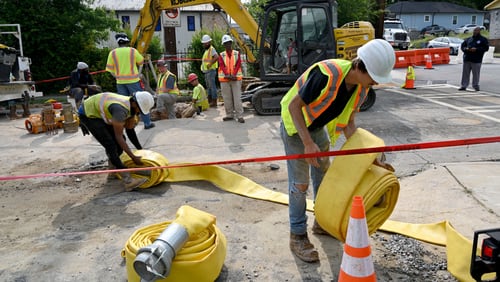As the Ga. 400 toll ends this week, tollpayers can rest assured that over the years their quarters, dimes and nickels funded what they were supposed to.
And much more.
Documents and other information acquired by The Atlanta Journal-Constitution reveal that for years the State Road and Tollway Authority used drivers’ money for purposes that had nothing to do with building, maintaining and operating Ga. 400. The infamous purchase 10 years ago of land at Atlantic Station was just one instance of much broader mission creep.
The far-flung spending conflicted with promises the state made in the days when it was scrambling to justify the toll and overcome Georgians’ deep aversion to the whole notion of pay-to-drive. SRTA quietly forged a way around those promises, then, in essence, used Ga. 400 tolls to lay the groundwork for a future in which tolled lanes are the backbone of the state’s transportation strategy for metro Atlanta.
Along the way, the roughly $20 million a year collected from Ga. 400 drivers helped fund the salaries, overhead and travel expenses of dozens of administrators, engineers and financial experts, including a trip to Spain. Other money went to administer highway grants and manage the issuance of bonds for transportation projects across the state.
As metro Atlanta embarks on the new era of tolling, the AJC’s findings offer lessons on the importance of public transparency, policy-setting and planning ahead.
Promises
Back in the late 1980s, when the state was trying to convince the city of Atlanta to allow Ga. 400 to extend six miles inside the Perimeter, the promises about the toll money were clear, Sally Silver remembers.
“We were told that it would be used along 400,” said Silver, a north Buckhead resident who protested the road.
Her memory is sound. A 1988 agreement between the state’s top transportation officials and the federal government stated: “… all toll revenues received will be expended only on the Ga. 400 Extension and only for the construction costs … and for costs necessary for the proper operation, maintenance, and debt service for the Ga. 400 Extension …”
Says Silver: “That was a lie.”
In 2002, state and federal officials quietly loosened the 1988 legal restriction. Soon after, SRTA bought a $10.4 million piece of land at Atlantic Station.
That purchase sparked outrage. SRTA’s board responded by enacting a new policy in 2003 to regulate the expenditure of “excess” toll revenues: They could only be spent to benefit the corridor around Ga. 400.
Wiggle room
But the policy had a loophole. It exempted spending that was needed to support the activities and operations of the authority. Those activities and operations weren’t “excess,” and they turned out to be diverse:
- Governors chair the SRTA board, and under at least the last three governors, toll money has funded development of transportation plans as far away as Savannah. SRTA worked to make the case that it was suited for this broader work. In 2005 it even commissioned, for $8,778, a history of itself.
- One major beneficiary was the I-85 HOT lane project. When it opened, Gena Evans, then the director of SRTA, wrote in an internal email: "For more than two years, the effort and energies of every member of the SRTA Team have been focused on this major milestone."
- The authority has also taken on a finance role, with toll-paid staff processing bonds for transportation projects across the state. Its staff includes a comptroller, three accountants, a budget manager, a treasury operations manager, a treasury support specialist, a revenue control manager and support staff.
- Since 2009, SRTA staff have run the state's Transportation Infrastructure Bank. As with the transportation bonds, the money distributed comes from the state. But it's administered by toll-paid staff, assisting small projects from Cumberland to Stone Mountain to Gwinnett County.
“Obviously, the scope of what SRTA does has expanded,” said Jim Croy, who led the authority from 2000 to 2003 under former Gov. Roy Barnes.
SRTA officials say they don’t know how much toll revenue they’ve spent on things other than maintaining and operating Ga. 400.
“It’s hard to say,” said Bert Brantley, the authority’s deputy executive director. “The decision was made years and years and years ago that SRTA would fill a void, a gap in the state’s transportation planning and infrastructure development.”
Few staff cuts
Nearly every SRTA employee has been necessary to Ga. 400, according to Brantley. But that’s a far cry from saying they’ve worked solely — or primarily — on that one road. In fact, just five of SRTA’s 49 staff positions will be eliminated after the Ga. 400 toll operation ceases.
The 44 who will remain include a director of continuous improvement, two quality assurance analysts, offices for procurement and project management, engineers, a director of marketing and communications and an outreach specialist.
(Nearly 50 toll collectors, who will all lose those jobs, are outsourced; Peach Pass customer service operators, also outsourced, will gradually decline in number.)
Under the heading of operations, SRTA has generally spent between $10 million and $14 million a year, including depreciation. That amount rose to $27 million in the most recent fiscal year as the state’s new toll programs heat up.
Operational costs include not only staff but overhead and expenses, such as a $774,000 accounting system that will track the toll revenues and spending associated with each of the new toll projects. SRTA staff have traveled to dozens of conferences and meetings on tollpayers’ dime, from San Diego and Miami to Vancouver and St. Simon’s Island. Tollpayers also helped fund an educational trip to Barcelona and Madrid, when Georgia was contemplating privatizing public toll roads as they do in Spain.
The Ga. 400 toll has funded most, but not all, of those operations. Other revenue sources included violation fees from Ga. 400 drivers who failed to pay the toll ($11 million cumulatively), advertising at the toll plaza ($150,000 a year), rent paid by a cell tower owner ($70,000 a year) and, until 2003, tolls from the Torras Causeway bridge ($1.7 million a year).
(The I-85 HOT lanes bring in toll money too, but that project operates at a loss.)
And when Gov. Nathan Deal decided to end the Ga. 400 toll this year, the state came up with $26 million to help cover the cost of various projects linking Ga. 400 to other roads, projects undertaken with the expectation of future toll money.
Lessons learned
Even some state officials say they aren’t aware of where the Ga. 400 money has gone.
State Sen. Brandon Beach, R-Alpharetta, serves on the Senate Transportation Committee. He is president of the the Greater North Fulton Chamber of Commerce, was an influential member of the state Transportation Board and has dealt often with SRTA. After a SRTA presentation before his senate committee this year, the AJC asked him about the funding diverted from the Ga. 400 corridor.
He said he didn’t know about it.
SRTA officials say they’ve been accurate in communicating where the money goes when they say it goes to operations.
“To my knowledge that is exactly where money’s been applied,” said SRTA executive director Chris Tomlinson. As for restricting it to the Ga. 400 corridor, he said, “the things that the authority does are broader than that.”
Some tollpayers say the functions may be legitimate, but they shouldn’t be funded by the drivers of just one road.
“It’s robbing the citizens,” said Dee Roodehchi, an occasional Ga. 400 driver. “That’s the government run amok.”
The way of the world
The pattern was predictable.
Almost from the beginning, toll revenues beat the forecasts, dropping extra money in the bank. Governors are always under pressure to come up with transportation solutions, and that takes money. Most of the state’s transportation dollars are allocated decades ahead, so money for a new project must be taken from another.
But not the toll money that flowed into SRTA. Thus, the burden of funding new initiatives fell to Ga. 400 drivers.
Nevertheless, if Atlanta drivers had known 25 years ago that Ga. 400 would generate money beyond what was projected, they would “for sure” have demanded that the surplus be reserved to benefit them, said Clair Muller. She spent 20 years on Atlanta City Council after battling over the road as a neighborhood advocate.
“That was exactly what we should have been doing,” Muller said, “working with the state to solve city transportation problems with that money.”
The end of Ga. 400 tolls won’t create a budget gap for any existing highway projects. But in the near term, the DOT will have to find money within its own, tight budget for things the tolls might once have subsidized. Looking ahead, the state has been candid about the fact that tolls in places such as the express lanes on I-85 and the planned ones on I-75 are probably forever.
That’s one of the lessons learned from the Ga. 400 experience, said Tomlinson.
And if those projects should ever make a profit, SRTA has placed no restrictions on which roads the surplus might be spent on, Brantley said.
Make no promises, break no promises.
About the Author






